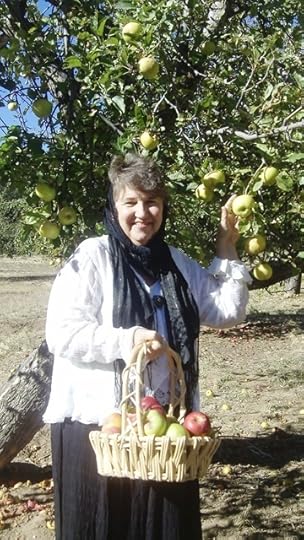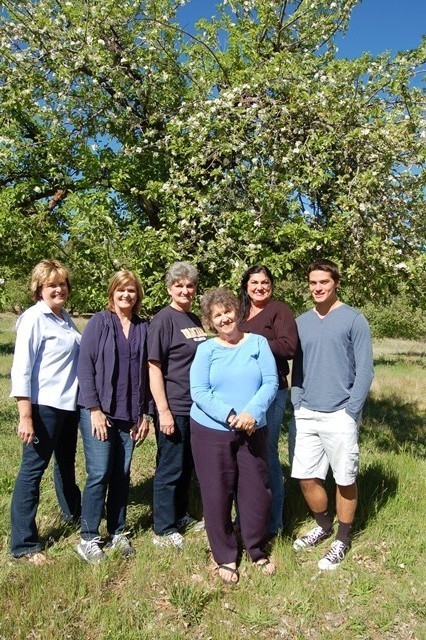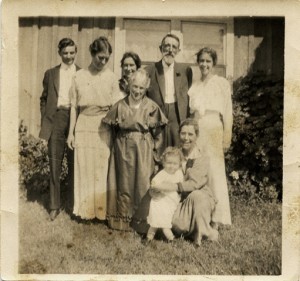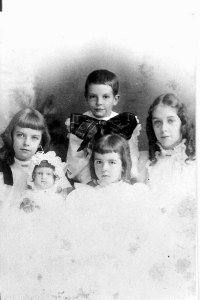Barbara Anne Waite's Blog, page 3
February 17, 2015
Research Adventures
I have a new picture for Elsie’s second book. It came down to me from “the cloud.” Well, it did come by e-mail and I felt like it floated down from heaven. I had read in Elsie’s notes (written when she was 18):
“1906- After Papa bought the Apple ranch on Palomar he spent the fall living on the mountain. In June he drove the wagon down to Long Beach and my sisters and I returned to the mountain for each summer. Those trips will never be forgotten. Sometimes we more or less followed the coast as far as Oceanside. We camped out at night. Papa grew to love camping so much that we used to laugh about it and say that he must have gypsy blood. In those days Southern California had vast wild areas and scattered ranches. Along in the afternoon we would watch for a farm where we might be able to buy hay. Still trying to save weight Papa would get only enough for feed for that night and the next morning.
Next we looked for a camping spot, near the lonely road and not far from some farm where hospitality extended to the use of water. A fire would be built; groceries for supper would be unpacked. It was then that the hay left for the team’s breakfast would be spread as a mattress for our beds.
Our side journey to the Guajome Ranch was probably a part of one of our travels by way of Oceanside, our alternate route between Long Beach and the mountain. In 1906 we camped not far from San Juan Capistrano Mission, no doubt the first night out from Long Beach. It was down toward the beach in a wild, isolated spot, and that night coyotes howled nearby. My dear Caroline Harnett was going with us for a month at Palomar. Used to her huge family, she had never been away from all of them a night before; nor had she ever slept in the open. I remember her terror at that weird wailing, which I still love to hear anywhere. Once in passing near the mission we spent some time at its ruins. A Kodak picture shows me on horseback among the fallen walls.”
Elsie came from a long line of “preservers of history,” (she was too genteel to be referred to as a hoarder). As a child I remember days when she opened her cedar chest to reveal amazing bits of family history. When Elsie retired from serving as a school librarian for La Mesa elementary she began to visit history classes displaying some of her treasures from the cedar chest. There were invitations to inaugural balls from the 1800′s, and an autograph book that included Ulysses S Grant and Abraham Lincoln , among others. There was also a treasured letter written to her aunt from Susan B. Anthony. Among her treasures were photos of Elsie’s grandfather, William Nairn Reed. He had come west with the band of 49ers. There were pictures of cousins left behind in Virginia. I knew none of the people in the pictures from Virginia, but being the preserver of history I held onto them.
I wanted that photo from 1906 of Elsie riding her saddle horse.
My sister Nancy and I had searched all of our family photos – but that picture was not among all the treasured photos we had from Elsie. I had recently discovered a cousin named Mark, a descendant of one of Elsie’s Virginia cousins, via ancestry.com. (Mark and I share William Nairn Reed as a great-great-grandfather.) I mailed him some photos that Elsie had saved among her treasures that were of his grandmother as a child. (Elsie kept in contact with her Virginia cousins when her family moved West in 1897, and they traded photos.) A couple of weeks ago Mark began to email photos to me asking if I could identify the people. He told me his photos inherited from his grandmother were in an envelope marked “California Cousins.” I restrained the shout that nearly escaped me while sitting in the library when I realized Mark had emailed me the very photo I had been searching for – Elsie on horseback at Capistrano Mission. In 1906 when photos were developed they didn’t come with doubles! The photo is labeled “Elsie on horseback beside the ruins of San Juan Capistrano mission.” Photos delivered from the cloud up in heaven.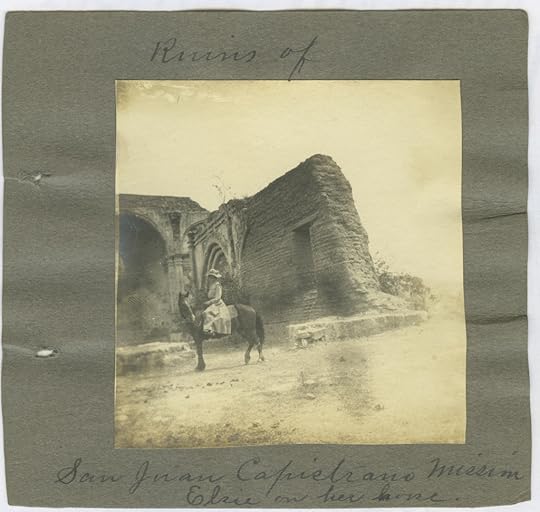
I am so thankful we are now at 303 reviews on Amazon. I have another new cousin and what an adventure I am having writing this second book.
November 19, 2014
Apple Harvest on Elsie’s Mountain
Picking apples from trees Elsie’s father planted in 1904 .
I recently enjoyed participating in the Palomar Mountain State Park Apple Harvest Fest. There were over 700 visitors that enjoyed the crisp fall mountain afternoon. It was memorable for me since many of the activities were unchanged from Elsie’s years on the mountain and my years as a child.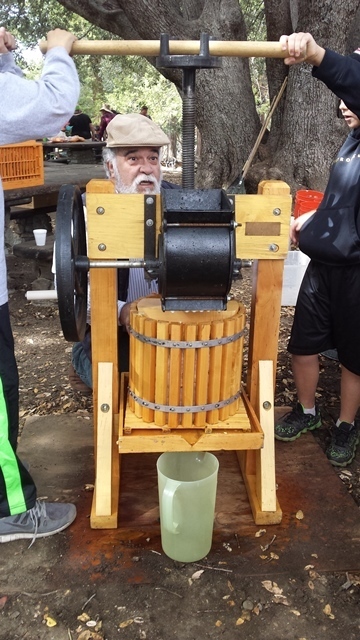
Apple Cider Press
There was fresh apple cider being pressed, much in the same manner as it was done by Elsie 100 years ago (and 50 years ago when I was a teen). The children were enjoying the process of turning the large wheel that crushed the apples releasing the pungent smell. Of course it also released a few worms into the mix! The cider was heated, cinnamon stick added and I suppose the extra worm protein was the same as it has been for generations. Apple desserts and cider were free and in abundance, chili and cornbread sold.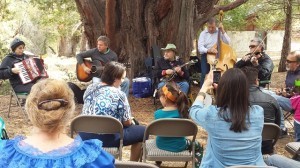
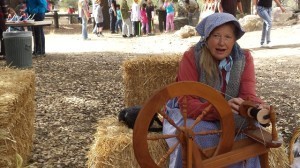 Folks were also entertained by mountain music, square dancing, Cecilia Borden spinning goat hair, and crafts for the children. I dressed in period costume (a resurrected outfit from a presentation of Fanny Crosby) and shared some of Elsie’s mountain apple history stories.
Folks were also entertained by mountain music, square dancing, Cecilia Borden spinning goat hair, and crafts for the children. I dressed in period costume (a resurrected outfit from a presentation of Fanny Crosby) and shared some of Elsie’s mountain apple history stories. 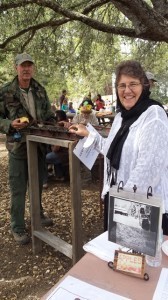
Curt & I demonstrating vintage apple sorter
We demonstrated a vintage apple sorter that has survived 100 years of mountain weather. Perhaps the most awesome thought about mountain apple history for me is the longevity of the trees planted by my great grandfather 110 years ago. In the winter those old trees appear to be ready to be used for firewood. They are twisted and gnarled revealing years of neglect. But each spring the gorgeous young blossoms appear on these aged trees and each fall the apples delight many of us with apple cider, applesauce and an occasional apple dessert. Lovely to see how old can still be highly productive.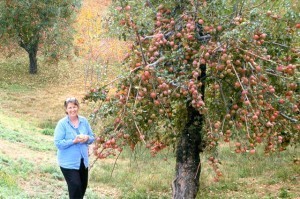
Alonzo Hayes planted this tree in 1904.
Elsie recorded in her journals that they began picking apples August 1st with 10 boxes of early apples picked. The trees were so heavy with fruit that they held the branches up with props. One tree yielded 9 boxes. The apples sold for $2.65 for a 100. Apple varieties included Smith Cider, Ben Davis, Palomar Giants, Jonathans and a number of others. Jack pruned 260 trees in the spring. One thanksgiving there was snow on ground and they still had 2 apple pickers working. Elsie cooked fifteen stuffed quail as a substitute for a turkey.
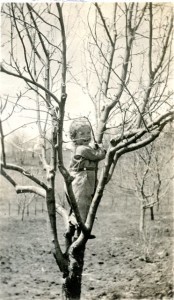
Catherine Roberts, my mother, in an apple tree 1920.
One news article from 1923 said Jack & Elsie hired about 20 apple pickers during the season. Charming Swiss immigrant Gus Weber was in charge. That article told that once the apples were in they were graded, sorted and packed.
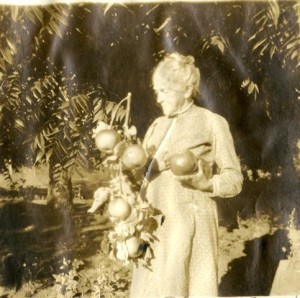
Elsie’s Aunt Mamie holding Palomar Giant apples.
This second book I am compiling is taken from Elsie’s records of life on Palomar Mountain. It covers her years as a teen (spending summers there), then her years as a young wife and mother operating the apple resort year round for 5 years, and finally her last 40 years as a widow and grandmother still reveling in the joy of trips to her beloved mountain.
September 22, 2014
Research in the New San Diego Public Libary
Research is an addictive thing. I will admit I love making discoveries. For our 47th wedding anniversary we rode the train from Oceanside to San Diego. We then took the trolley to the new San Diego public library. It opened a year ago, and was thirty years in the making. It has a reading room with a three story dome; over a million books; it is nine stories and nearly 500,000 square feet. It is awesome architecture.
My quest was in the San Diego history section and the gal who works on the 9th floor was helpful in so many ways. We researched old city directories that listed where people lived in 1924. I wanted to locate the home Elsie and Jack moved to from Palomar in 1924. We recently drove down Panorama Ave., the street with almost all homes vintage, from early 1900’s. Elsie address was 4800 Panorama, but the last house on that street today is 4798. What happened to 4800? Unfortunately, I couldn’t find what happened to the house, but I discovered some amazing facts about that small neighborhood while at the library. The street ends at a small park of which I took little notice. Research revealed that the Mission Cliff Park was apparently “the place to go” just a few years before Jack and Elsie and my mother moved there. In 1897 it even had a German beer garden, a merry-go-round, a shooting gallery and a pavilion for dancing parties. Vaudeville companies performed there and there was a wooden observatory that allowed patrons to view Mission Valley. By 1907 there was a syndicate in San Diego that had plans to build exclusive luxury homes along Panorama Drive. It was THE place to live. Elsie, Jack and my mother Catherine rented a home on that lovely street overlooking the valley. On many days in 1924 Elsie wrote in her diary, “…worked in the canyon and love that.” That canyonside is right above Texas Street and it is hard to imagine anyone spending time developing a garden on that steep hillside above that very busy street. It was a wonderful time for her.
Elsie also wrote about one of the men hired during apple season on Palomar who seemed to be able to display his knowledge on almost any subject during meal times. Apparently this apple picker worked during apple season so that all winter he could rent a cheap room in downtown San Diego near the library. He simply spent months at the library absorbing facts and history. Sounds like a plan to me!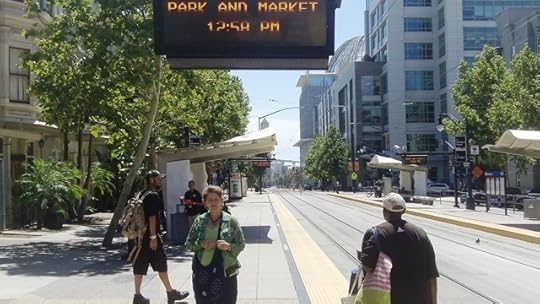
Waiting for the trolley. The large dome behind me is the new San Diego Public Library
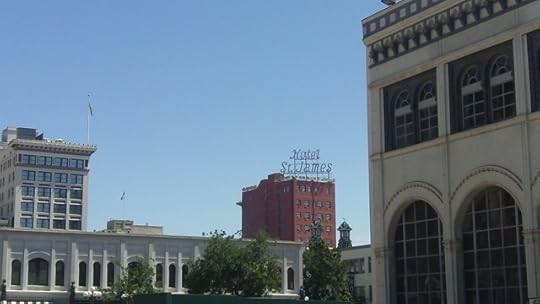
The St James Hotel will be mentioned in the next book. I will leave it a mystery as to how it is involved.
It has been nearly 3 years since I first published “Elsie.” I continue to hear from readers that have enjoyed reading about her life of 100 years ago. Thrilled that the number of Amazon reviews are now at 291. Curt has promised a special treat if I reach 300. Elsie would be amazed.
April 24, 2014
RE-DISCOVERED COUSINS!
April was an amazing month of rediscovery. My mother was an only child, so I had no first cousins on her side. My mother had nine first cousins. As a child I remember a couple of reunions with my mother Katie’s cousins. When I left home in 1967 I lost touch with that side of the family. After “Elsie” was published I sent a copy to Dorothy, Elsie’s first great-niece mentioned in the book. I had a lovely letter from her thanking me for the book. I also had a lovely letter from Elsie’s youngest nephew Cameron Burley. Yet, I remained out of contact with most of the other relations. I was thrilled when a Pinterest post of the book “Elsie” was noticed by one of my long-lost relations. She contacted me and thus began a lovely time of reconnecting. It was fitting that the first gathering of lost cousins should take place on Palomar Mountain. We shared old family photos, family history and the connection between Elsie and her sisters Hylinda and Alice.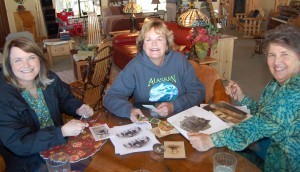
Alice’s granddaughters Marilyn and Chris enjoying old family photos with me.
We stood beneath the apple trees our great-grandfather had planted in 1906.
Like the glorious new blossoms on the trees we had a friendship blooming there on Palomar.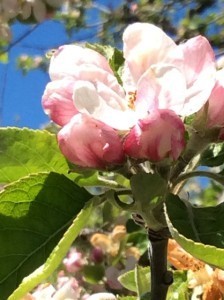
Apple blossom’s from 1906 tree.
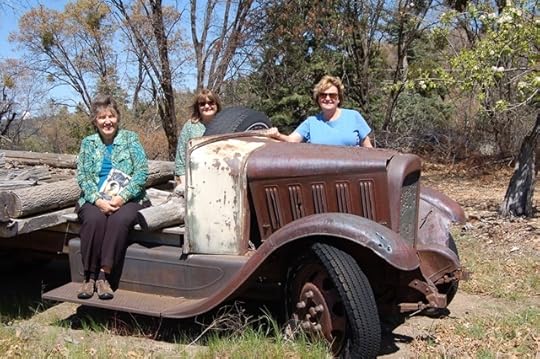
There are no words to describe the thrill of knowing Elsie and her sisters had loved and played where we took our photos 110 years later.
Chris, Evelyn, Rosie, Edie, Ray & Barb beneath tree that our great grandfather Alonzo planted 1906.
Ray, Edie’s handsome young son, represented the fifth generation of a Hayes relations to stand there.
When my grandchildren and my brother Dan’s grandchildren gather apples there they represent Alonzo Hayes’ 6th generation gathering apples from his trees.
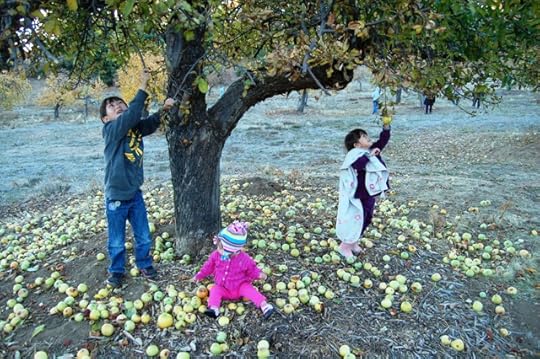
Mateo, Talia & Sarina Waite – 6th Generation under Alonzo’s apple trees in fall, 2012.
Perhaps my mother’s favorite cousin was Samuel Urshan. I remember Uncle Sam as a handsome and charming man. Sam had been a captain in the US Army Air Force during World War II. He flew 29 bombing missions over Japan. In 1952 he flew 45 missions over Korea. His self-portrait hung in my sons’ bedroom for many years. I knew Ray might enjoy this painting created by his great uncle Sam in 1947. 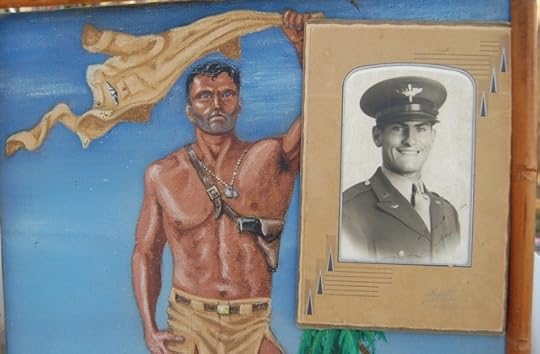
Sam Urshan- self portrait painted 1947.
I was delighted to give Ray this reminder of family history.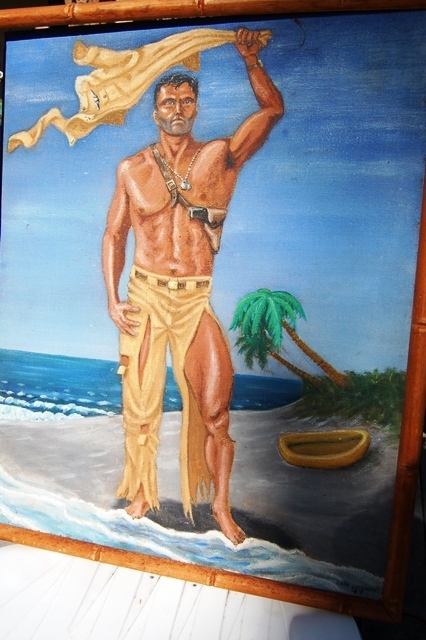
As far as I know, Sam never had an experience like he painted here.
I think of how pleased Elsie would be that the family reconnected on her beloved mountain. The continued story of the Elsie’s years on Palomar is coming together. I hope to publish it by December. I am grateful that Elsie’s story of her Arizona years continues to sell. Montezuma Castle National Monument just ordered an additional 20 copies as I write this. That brings the orders from National Parks to 570 copies. Thanks to all those who have added 277 Amazon reviews. I never dreamed publishing Elsie’s story would reconnect me with cousins. What a glorious gift Elsie has given me.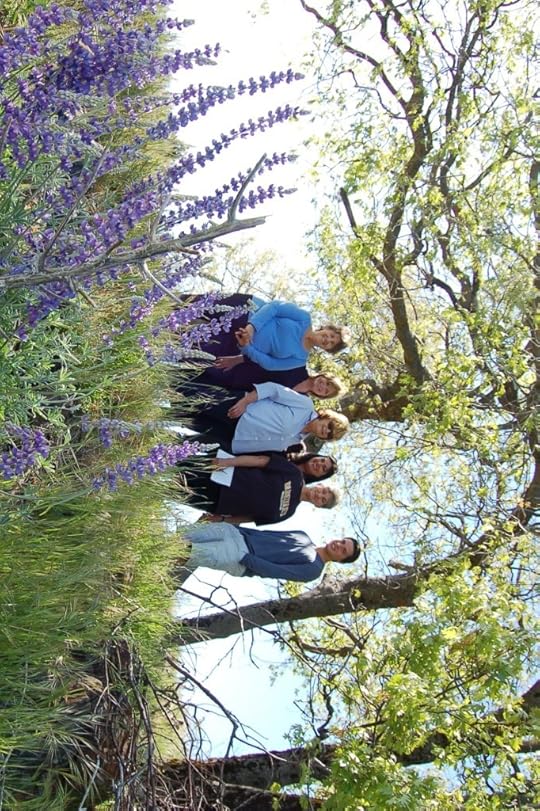
Cousins, granddaughters for Elsie and her sisters on inspiration point where Sunday Vespers took place 110 years ago.
March 30, 2014
Vintage photos Elsie’s Family
Ernest & Alice Burley /Hylinda/ Alonzo Hayes & Elsie
Front: Aunt Mamie, Dorothy Burley & May Carrie Hayes
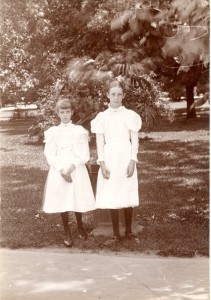
Elsie & her older sister Hylinda before they moved from Virginia to California. Appears they were at the cemetery
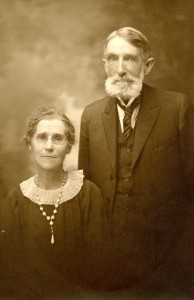
Alonzo Hayes & May Carrie Reed Hayes
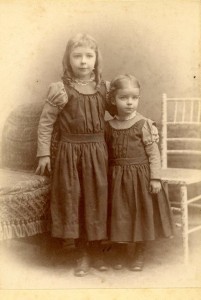
Hylinda and younger sister Alice. I wonder why Elsie was not in this picture
Elsie with her sister Alice and Alice’s son CameronMarch 24, 2014
Elsie’s Ancestor Ended Salem Witch Trails
March is recognized in the USA as Women’s History Month. I love reading about historical women and the contribution they have made to history. Elsie was a great story teller and I loved hearing her recount family stories. Often it is after it is too late to question our family that we become interested in the old family stories. Perhaps because we are so busy creating our own story that we fail to realize how important history within our own family is.
I remember Elsie telling me a story about the Hale side of the family. I knew Nathan Hale, the martyr spy, was way back there in our family history. My brother was named Daniel Hale Beishline in honor of the Hale side of the family. Elsie had often told the story about Rev. John Hale, born in Massachusetts in 1636, graduated from Harvard in 1657. He was the pastor of the church in Salem, Massachusetts from 1668 for 33 years. John Hale was present during the witchcraft trials in Salem. In 1692 Rev. John Hale’s wife Sarah Noyes Hale was accused of witchcraft. Elsie had always told me that Sarah Hale was of such good character that public faith was shaken in the trials after that. The community was convinced that the accusers had perjured themselves, thus Sarah’s life put a close to the tragedy of the witchcraft trials in Salem. Years after Elsie death I watched a movie called “The Crucible” (which I would not recommend) and there before me was the story of the end of the witchcraft trials and Sarah Hale’s role in that, just like Elsie had told me. Sad that a movie helped validate what Elsie had described to me as a child. Thank you Elsie for telling me stories.
Here is the answer from a question about Elsie’s sisters for a reader.
Hylinda married Dec, 1919 to Absalom Urshan and had 2 children, Sarah and Sam- Hylinda died in 1934.
Elsie’s only child was my mother Catherine May Beishline born in 1918.
Alice and Ernest Burley had 7 children. Two of Alice’s children, Rosalyn and Cameron are still living. 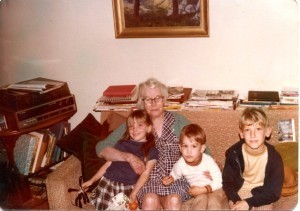
1978- Elsie age 90 surrounded by books
and grandchildren Carin, Christopher & Dan Waite
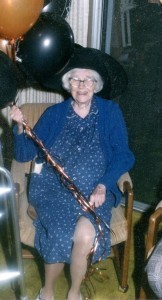
Elsie -age 97- her ever present smile. 1985
February 26, 2014
STEPPING BACK IN TIME
I love books that take me to faraway places and new experiences. One of the unexpected delights in writing “Elsie” has been meeting readers from faraway places. This last week I was honored and privileged to meet Mary Campbell and her 92 year old mother Edith Cox. As soon as we met, Mary explained that everyone calls her mother “Granny.” I was drawn to Edith, and to call her “Granny” during our short visit was a sweet privilege. Mary had written a year ago explaining how she had grown up on a 22-acre apple farm near Hendersonville, North Carolina. I was intrigued when Mary described how her life growing up in N.C. was similar to Elsie’s first Arizona year. Mary shared with me a 1969 newspaper article written about her family farm. The article described the farm as having no indoor plumbing, no electricity and must be reached on foot. It said “Looking down on the old two room cabin it seems time has rolled back at least 100 years.” The article spoke of light from kerosene lamps , the wood stove for cooking and water being carried from the spring for drinking, bathing and washing dishes. 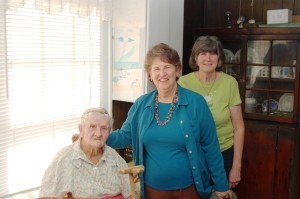
Edith Cox, Barb and Mary Campbell
Mary showed me the beautiful antique butter churn she used as a girl. We viewed the smoke house still in use. Edith still uses the classic wood stove for heat and cooking. Her other daughter had prepared greens and beans that sat atop the stove ready for the day ahead. Edith demonstrated her electronic Bible, a small device that she could both hear and see. Mary had written me a year ago and I knew we would be kindred spirits. Mary wrote telling me that “Three days after I turned 18 I left farm life. No more hoeing and picking beans and apples for me.
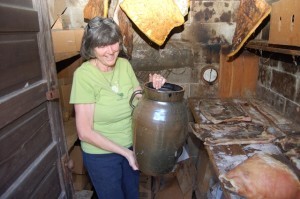
The barns are larger buildings to the top of photo. The white roof to the front is where Granny now lives. The small two room cabin where Mary grew up is small building in the center right of photo.
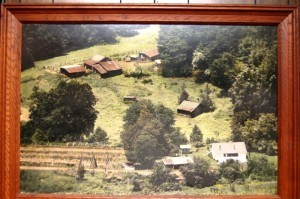 I joined the Air Force in Aug. of 1970. In April of ’71 I married an AF sergeant from Ohio. I am so honored to have grown up in the little cabin and have the wonderful memories of a time long lost to modern technology. My Uncle Daniel (Dad’s brother) built a small house for Mama and Daddy in 1973 that replaced the 2 room log cabin.” When Mary’s husband retired from the Air Force they came home to Mary’s N.C. farm and her Mama.
I joined the Air Force in Aug. of 1970. In April of ’71 I married an AF sergeant from Ohio. I am so honored to have grown up in the little cabin and have the wonderful memories of a time long lost to modern technology. My Uncle Daniel (Dad’s brother) built a small house for Mama and Daddy in 1973 that replaced the 2 room log cabin.” When Mary’s husband retired from the Air Force they came home to Mary’s N.C. farm and her Mama.
Mary also wrote this fun story:
“In days past it was normal for farmers in the area to drop by and have lunch with Mama and Daddy unannounced. It never seemed to bother Mama, in fact, she thrived on it. Daddy always bragged on Mama’s cooking. One of my favorite stories is back in the 80′s a car pulled up in the yard and dad hollered, ‘Come in.’ A man appeared at the door and said, ‘Well, I can’t, my wife is in the car and has no legs and we don’t have her wheel chair.’ Daddy took a chair from the table and together Dad and the man placed the lady in the chair and sat her at the table. They all four enjoyed a great meal and fellowship and after an hour or so they left. Daddy said to Mom, ‘Just who was those people?’ to which Mama said, ‘Well, I don’t know. I thought they were your friends.’”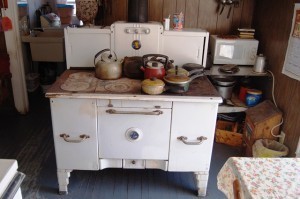
Granny still cooks on this classic wood burning stove.
As I left Granny called me back inside because she wanted to offer me a gift. I will treasure the small thimble and cute little dragon-fly garden ornament that says “God Bless You.” It is clear God has richly blessed Edith with daughters that love and care for her. I felt blessed for having been privileged to visit this family.
I appreciate so much the many that have taken time to write saying they appreciated “Elsie.”
January 22, 2014
100 Year Old Birthday Wishes For Elsie- From Her Sister Alice
Elsie (holding her lifelike wax doll),Alice & Hylinda. Gilman is Elsie’s brother who died when he was 14.
Elsie Hayes was born on Jan 22, 1888 in Alexandria, Virginia. I was blessed to be her first granddaughter. I am deeply thankful that I had her in my life for 40 years. Perhaps one of the sweetest letters included in “Elsie’s book” is a rather short note from her younger sister Alice, written for Elsie’s 26th birthday, the first spent in Arizona. I share it with you today in tribute to the love these two sisters shared for over 90 years. They were more than sisters, they were friends. After both of their husbands had died Elsie & Alice took a 3 month trip to Great Britain to visit Jack’s remaining family in Wales and Ernest’s remaining family in England. Elsie was 80 when they made their first trip. I recently read the travel journal Elsie kept for that trip. They experienced a rich bond as sisters and a life-long friendship. For some unknown reason Alice’s pet name for Elsie was “Sylvia.” So here are Alice’s 100 year old Birthday wishes for Elsie:January 22, 1914
Sylvia Dearheart,
This is just a little word for your birthday—which is so wonderfully different from the one a year ago! Whole cycles apart they are. You might have been the inhabitant of another planet a year ago so unsure you were of life’s substantial gifts, because the flesh was weak but now you are here and a world of blessings will make this the richest new year of all. Not that its path is clear, but I believe it leads toward clearer light and deeper gladness.
I am not going to write you any definite wishes. You know well enough that I wish you every lovely fulfillment, just as soon as God sees you are ready for the numberless gifts. I’m just thankful with you, beloved, and glad you are my friend for all the splendid years ahead; for the rich things your life will add with zest to mine. But my deepest wishes are written not on its pages but in your heart that will make no mistake in the deciphering.
God bless You Dear Elsie-Sylvia,
Your Ever Loving Alice
This 100 year old note brings tears to my eyes and a desire to communicate such rich words to my family more often. Thank You Elsie and Alice for continuing to teach me, now, 100 years later, the lasting value of sharing love with your family through letters. Elsie’s Birthday is still fondly remembered by this granddaughter who misses her and cherishes the record she left forever in her letters.
I am pleased that another 40 books were recently ordered by Arizona’s National Parks. Elsie would be amazed that 525 copies of her Arizona letters & diary entries have been sold by these two parks alone. I continue to be blessed by generous reviews, and humbled by a few negative ones as well. I laughed that one disgruntled reader wrote that she found the book “very old fashioned.” I find it amazing that 261 have taken the time to comment in a review. Thanks to all of you who keep encouraging me to finish “Elsie’s Mountain Years.”
Maybe take time today to surprise someone you love with a note that says “I’m just thankful with you, beloved, and glad you are my friend for all the splendid years ahead; for the rich things your life will add with zest to mine.”
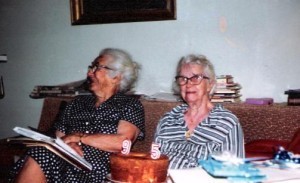
Alice & Elsie January 22,1983. Note the stacks of books- Elsie remained a life long lover of books.
December 10, 2013
The Gift of Family History
Recording Family History
What a gift Elsie’s diary and letters have been to me. Though they are quite ordinary, and some might even consider them “boring,” for me they are a treasured time capsule of what life was like more than 100 years ago.
Elsie’s Diary entry for today, 99 years ago, was one of the saddest that she wrote. Since high school days she and two very close friends had called themselves “The Triumverate.” One of the three, Caroline, died just before Elsie graduated from Long Beach High in 1907. Ruth, the remaining friend, had been ill for some time with tuberculosis. Elsie wrote:
Dec. 10th, 1914 “A day I cannot forget. I heard the sweet news about my little sister, Alice, and was moved and glad she is expecting. I went to the Women’s club, and in the evening to the movies with Mr. Connor, and dared not open a letter ‘til he left. Then I knew that I only am left of Triumverate. May God be with me. The girls helped. In a snowstorm we took a letter for Alice to the night train.”
What are you leaving behind that reveals something about your heart and life to those who follow? One hundred years from now there may very well be family members that will wonder what your life was like. Our youngest son will soon be 32. He was discussing the other day how much life has changed just during his 32 years. He says many young adults that are just ten years younger than he is can’t imagine a world without technology, cell phones, computers, instant google answers to almost any question. I find it amazing that Elsie when she was over age 90 wrote a poem about computerized dating in the early 1980’s. I recently was tossing papers and came across a financial journal we kept in 1967. I had forgotten how inexpensively we lived. It was interesting to read through that financial list. Other than perhaps a faded photograph, how much do we know about what life was like for our family of 100 years ago?
Elsie was my mother’s mother, and I was privileged to learn much from her about her family history. My father’s mother, Eva Letitia Woods, was a doctor in 1903. I have Eva’s quaint framed medical diploma. There must have been an interesting story behind becoming a female doctor 110 years ago. Sadly I know nothing of that part of Eva’s life. She died when I was 11 and I am sorry that I never asked her about her family history or what it was like to be a doctor in those times.
I challenge those reading this to consider writing a small notebook that will leave a record for those who follow of what gave you joy, what sorrows you lived through and what life was like for you growing up. In fact, I think grandmothers should leave some sort of testimony behind for each of our grandchildren. Record the ordinary things and someday they will be fascinating little facts that shed light on our ordinary lives. “Little House on The Prairie” was just that, a record of what life was like for an ordinary girl. “Elsie” is that sort of ordinary record too, of teaching 100 years ago in the Wild West. 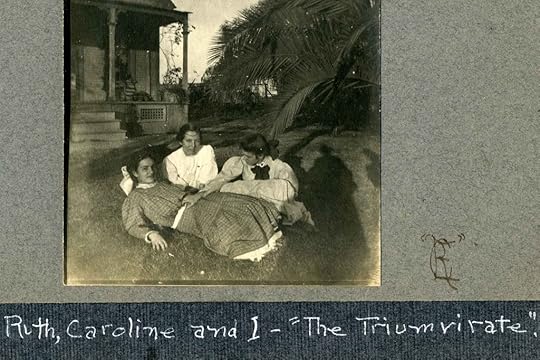
This photo from Elsie’s scrapbook shows how they signed notes to each other with their 3 initials, C, R, & E intertwined.
October 31, 2013
If Walls Could Only Talk
We just returned from a delightful 2-1/2 weeks in Southeast Asia. Our daughter, Carin, has followed in the footsteps of her great-grandmother Elsie. Carin and her husband Craig are teaching in Penang, Malaysia. Carin is teaching High School English at an international school. Elsie would be thrilled to know that Carin is an English teacher. While Carin was on fall break we took a wonderful couple of days and drove 6 hours up into the mile-high Cameron Highlands. Penang is 5 degrees North of the equator and is hot year round. The Cameron Highlands have been a refreshing retreat since the road was completed in 1931. Tea plantations were begun by entrepreneurs, and British colonists discovering the cooler climate of the Highlands began to make it a popular retreat. In 1934 Anne Griffith-Jones opened a boarding school called Tanglin in the Cameron Highlands. By the early 1940′s the school consisted of 150 students, with 22 qualified teachers, most of the teachers being from Great Britain. Its curriculum was based on the British education system. In 1942 when the Japanese invaded Malaya the school was closed. Eventually the school was sold and transformed into a lovely guest house, now called Bala’s Chalet, where we spent our two nights in the highlands. Anne, born in 1891 was 3 years younger than Elsie. I can imagine they would have had some delightful chats if they would have met. Anne was the daughter of a Welsh barrister. In 1923 she came to Singapore on a 3 month holiday and decided to stay. One article described Anne as a “…traditional Victorian Schoolmistress.” She had originally opened the Tanglin Day School in Singapore, using traditional bamboo and attap palm leaf huts. In 1934 the school was moved to the Cameron Highlands. During WW II Anne was interned in Changi Goal POW camp and organized a makeshift school for internees.
Bala’s Chalet is charming and very whimsical and we had a delightful time. But I wished I could hear the walls talk. I could imagine Anne discussing how to deal with the homesick British schoolchildren. I could imagine those students discussing horseback riding and jungle walks. I could even imagine a conversation between Elsie the educator and her contemporary Anne of the Cameron Highlands. I think Anne’s story would make a great book.
Bala’s Chalet built in 1935, formerly Miss Anne Griffith-Jones Tanglin school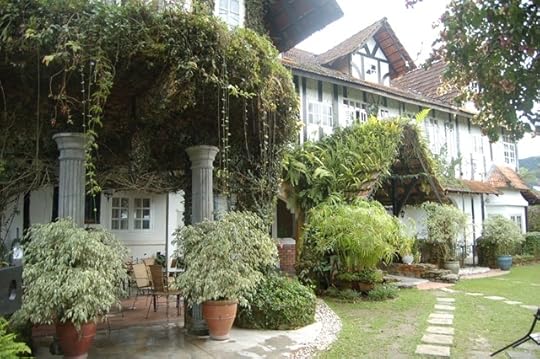
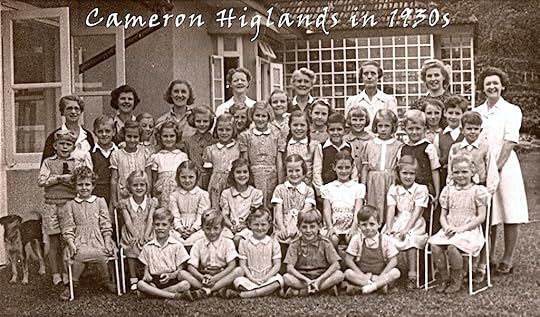
Miss Anne Griffith-Jones (back row, fifth from left) with her staff and pupils outside the Tanglin Boarding School (c. 1930s). Photo credit: Tanglin Trust School, Singapore.
The school continued to grow until the outbreak of the Second World War. After the war, it reopened but was placed on armed guard. It closed in 1948 due to the advent of the Malayan Emergency.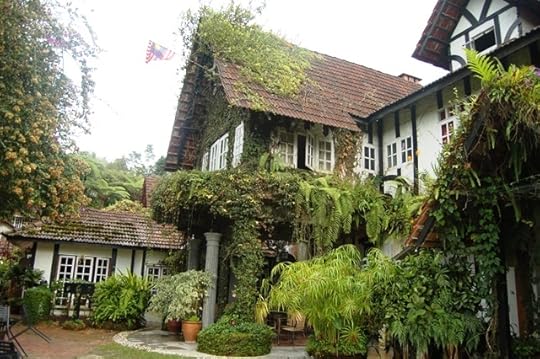
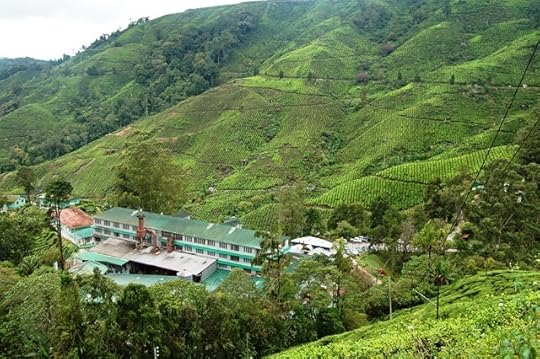
We visited a tea plantation in the Cameron Highlands and it was fascinating to view the lush green hillside covered with tea bushes that are close to 100 years old. If you ever desire to visit South East Asia I highly recommend the Cameron Highlands, Bala’s Chalet and dinner at The Smokehouse. Listen and maybe you will hear the walls talk about the history of this delightful area. Elsie would have loved it, I certainly did.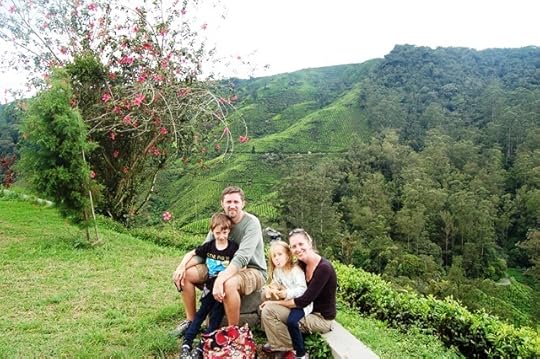
Carin & Craig and Edyn and Gabriel in the Cameron Highlands.

